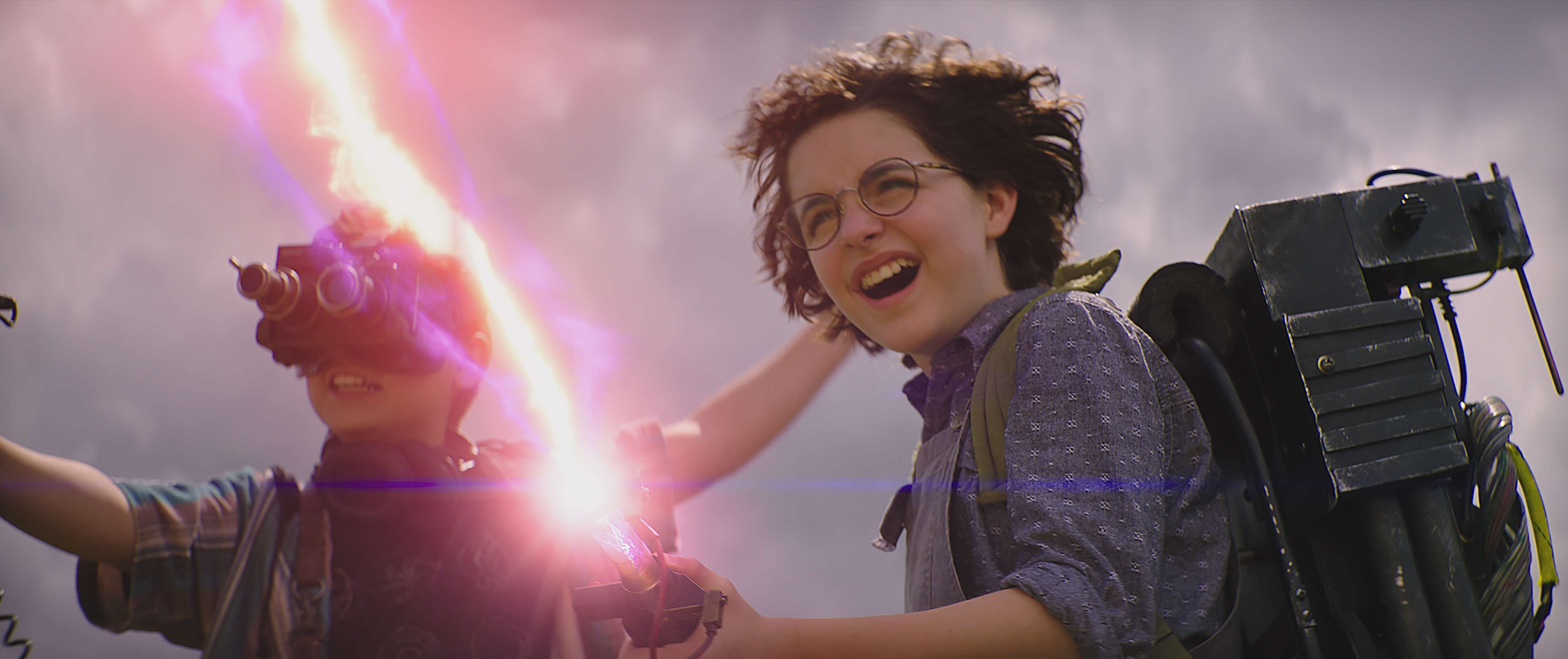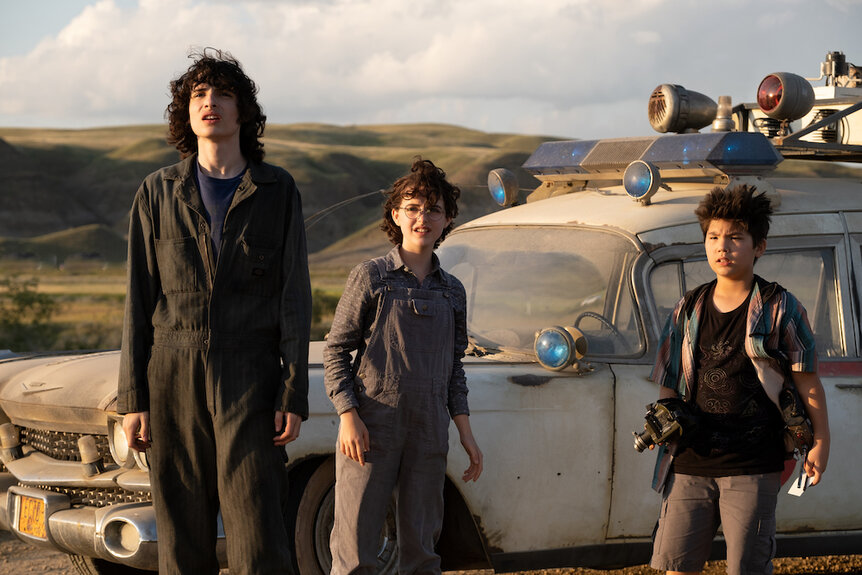Create a free profile to get unlimited access to exclusive videos, sweepstakes, and more!
'Ghostbusters: Afterlife' director and cast brought the franchise back to life — and it came back a little different
The new Ghostbusters movie was inspired by The Goonies and Star Wars, but it also draws heavily on a nostalgic vision of the '84 film.

For a franchise that's based on the premise of keeping the dead where they belong, Ghostbusters sure can't seem to stop coming back.
The newest entry in the franchise, Ghostbusters: Afterlife, comes three decades after the original '80s films and five years after an attempt at an all-women reboot met mixed reviews and an ugly, misogynistic fan backlash. Afterlife is, tonally, quite different from all the Ghostbusters movies that came before it; while earlier films were comedies about a bunch of middle-aged folks searching for their professional calling in a paranormal-infested New York City, Afterlife is a very Americana coming-of-age story about family, set in a small town that's perpetually bathed in golden hour light.
You'd be forgiven for being concerned that the new movie is a crass attempt to deflect backlash and cash in on the popularity of Stranger Things. No, really — Ghostbusters: Afterlife director Jason Reitman gets it.
"I understand your cynicism," Reitman tells SYFY WIRE during the press junket. In many ways, Afterlife does manage to overcome that innate cynical instinct that comes from seeing yet another nostalgic reboot or decades-later sequel. Still, there's an inherent tension between Afterlife's surprising success in subverting fans' expectations about what a Ghostbusters movie can be, and the weight of the IP at its core.
Afterlife tells the story of Phoebe (McKenna Grace) and her older brother, Trevor (Stranger Things' Finn Wolfhard), two kids who leave the city with their mom, Callie (Carrie Coon), when they're evicted and have no choice but to move to Oklahoma. Here, they discover that their late, estranged grandfather has left them a run-down farmhouse. However, they soon find that grandpa's old Ecto-1 is in the barn, there are proton packs in the house, and there's a supernatural phenomena brewing. As Phoebe and Trevor make new friends and learn about themselves, they'll also discover their secret family history — and maybe save the world.
Although Phoebe and Trevor don't know much about the original Ghostbusters when they start their adventure (one of this franchise's weirdest traits is how everybody just forgets that the existence of the supernatural was confirmed when a giant marshmallow man attacked New York City), they are still very much looking up to the previous generation. That's something that Reitman says was at the core of making Afterlife.
"We grew up fans of The Goonies, Gremlins, Back to the Future, Star Wars, and Ghostbusters. We wanted to make a movie that felt like that. [It's about] the young people who admire Ghostbusters," says Reitman, who happens to be the son of Ghostbusters '84 director Ivan Reitman, in addition to being an Academy Award-nominated director (Juno, Up In the Air) in his own right. "The original film was about the Ghostbusters. This movie is about the rest of us. The people who have always wanted to pick up the proton pack. The people who have always wanted to ride in the Ecto-1. And it's about a family trying to discover who they are."
"Jason's really captured the original tone of the film at the same time that he's passing it to this next generation of actors," says Coon. "He's the perfect person to do it. It's full of heart, it's family-friendly, and it's a beautiful story. That's the feeling you get when you see it, it feels like an old-school film."
Afterlife is indeed full of heart and a four-quadrant, family-friendly movie. The weird thing is that the original Ghostbusters isn't like that — at least not thematically. There's a different sort of wholesome charm to it. Paul Rudd, who plays Phoebe's Ghostbuster-enthusiast teacher Chad Grooberson, notes that Ghostbusters was written by Dan Aykroyd and Harold Ramis, who also went on to star in their own creation.
"When somebody creates and then makes something, and then they're in it, and it's their voice and vision, there's something different when that happens and it works. That's why I think people connected with it, and that's why it's stood the test of time," Rudd says.
Still, the original Ghostbusters is a scrappy movie — at times, it's even a mean one. It takes place in New York during one of the city's grimier eras and centers on fringe scientists who become blue-collar workers. It's sarcastic and anti-authoritarian in that uniquely ’80s way. Afterlife, in contrast, is glossier and warmer with its YA vibes and Amblin-esque story about family. Talking to Reitman and the stars, it's clear that they love the original movie, but it's also clear that it's been put on a pedestal — revered more as a sacred text than as the movie it is. It's a bit strange, then, that nobody seems to really recognize that what's good about Afterlife is how it's not like the movies that came before it.
Paul Feig's 2016 reboot is actually more similar in tone and intent to the original Ghostbusters than Afterlife is. The gender-swap aside, it was in many ways a straight-up retelling of the first movie. Phoebe, Afterlife's main character, is related to an original Ghostbuster, and this is the first time the franchise uses its main character in this way to explore raising a family in between bustin' ghosts. Her heritage aside, Phoebe, as a smart young woman who doesn't quite know her place in the world, is a departure from the typical Ghostbusters protagonist. (It's worth noting that the fans who seemingly hated the idea of lady Ghostbusters in 2016 don't seem to mind that Afterlife is largely about Phoebe and her mother.)
"The 2016 film was really important in that it opened up the idea of what a Ghostbusters movie could be," Reitman explains. "The 2016 film was hilarious and had incredible performances, but the most important thing it did for me, is that it set the table so I could make this film. It broke down the rules of what a Ghostbusters movie could be."
Afterlife is at its best when it follows Phoebe and Trevor on their journey — one that is exciting and heartfelt, full of engaging characters, good jokes, a healthy spirit, and some strong special and visual effects. (The use of some practical puppetry is one of the good ways Afterlife follows in the footsteps of the original.) Ironically, the best parts of Afterlife are the character and story moments that are least tethered to the original film and its Easter eggs, allowing the audience to accept the presence of the IP as a necessary evil in making modern blockbusters.
"It's a Jason Reitman movie," Grace says, succinctly connecting Afterlife to the director's other works like Juno or Young Adult.
However, just as Ray Stantz couldn't help but think of the Stay-Puft Marshmallow Man, Afterlife can't help but invoke its nostalgia. Recent trailers have hinted as much, so it's not really a spoiler, but the climax brings back some familiar faces. While it's exciting to see old favorites on the screen again, it also feels like they've intruded on somebody else's movie, because Afterlife was just fine doing a surprisingly different take on Ghostbusters before they showed up. For many viewers, this climax is a highlight of the movie. For others, it may prove that their cynicism was indeed warranted. The final moments of Afterlife put the film — and the future of Ghostbusters as a whole — in an interesting place. Afterlife, and the way the cast and director discuss it, seem to show that we're collectively misremembering what type of movie Ghostbusters was. At the same time, the parts of Afterlife that work show that the earnest, kinder, and gentler story about ghostbusting can be effective. Smashing whatever Afterlife is together with the original Ghostbusters crew does both a disservice, and it makes it a little harder to appreciate either movie for what they are when they're forced to be something that they're not.
Still, there's always a chance that, maybe, just maybe, it's possible to be too cynical. Sure, Ghostbusters was never the sort of movie that Afterlife is, but that doesn't mean there isn't something real and earnest in the original — or that the things we as a culture have chosen to take away from it and any possible revisionist history aren't still valid.
"The original Ghostbusters is actually just about — I think Ivan [Reitman] said it — it's about three best friends starting a business. That's really what it's about," Wolfhard says. "For me, some of my favorite movies are the ones where there are themes in it that make the story special. It's a very different mood, but I love that movie Superbad. That movie is about two best friends and they're going to college and they're really, really going to miss each other and they have separation anxiety. Everybody remembers it for the big jokes.
"There's always something deeper than what people think the movies are about," Wolfhard says.
Ghostbusters: Afterlife arrives in theaters on Nov. 19.



























